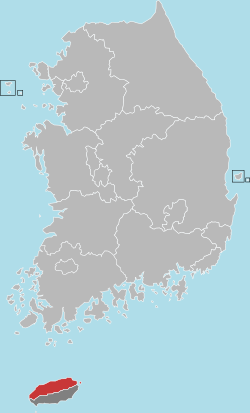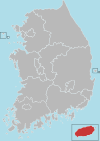Jeju City
Jeju (Jeju-si; Korean pronunciation: [tɕe̞.dʑu]) is the capital of the Jeju Province in South Korea and the largest city on Jeju Island. The city is served by Jeju International Airport (IATA code CJU).
Jeju 제주시 | |
|---|---|
Administrative city | |
| Korean transcription(s) | |
| • Hangul | 제주시 |
| • Hanja | 濟州市 |
| • Revised Romanization | Jeju-si |
| • McCune-Reischauer | Cheju-si |
Overview of Jeju City | |
 Flag | |
 Location in South Korea | |
| Country | South Korea |
| Province | Jeju |
| Administrative divisions | 19 dong, 4 eup, 3 myeon |
| Government | |
| • Type | Mayor appointed by governor, no city council (unique in Korea due to Jeju's autonomy) |
| • Mayor | Go huibeom (Democratic) |
| Area | |
| • Total | 977.8 km2 (377.5 sq mi) |
| Population | |
| • Total | 486,306 |
| • Density | 470.03/km2 (1,217.4/sq mi) |
| • Dialect | Jeju |
| Website | http://www.jejusi.go.kr/ |
Located on an island off the Korean Peninsula, Jeju has mild, warm weather during much of the year. The city is a well-known resort, with prestigious hotels and public casino facilities. In 2011, 9.9 million passengers flew between the two cities of Seoul and Jeju, making the Gimpo–Jeju route the world's busiest passenger air route.[1] Jeju welcomes over ten million visitors from mainland South Korea, Japan, and China every year.[2][3] The population of Jeju City is 486,306 people and 205,386 households (244,153 men and 242,153 women, February 2019).[4] The population density is 470.03 (per square km, 2015).[5]
History
The area of the city has played a central role in Jeju since before recorded history. The Samseonghyeol, holes from which the three ancestors of the Jeju people are said to have come, are located in downtown Jeju City.
The city has grown quite rapidly since the 1970s. Shin Jeju (신제주), or "new Jeju", was created some decades ago, up the hill from the airport and houses many government buildings. The thatched roof buildings that were common throughout the city until the 1970s are gradually disappearing.
The city was separated from Bukjeju County in 1955. However, in 2005 Jeju Province voters approved a proposal to merge the city with Bukjeju County, also merging Seogwipo with Namjeju County to create two large cities directly administered by the province. That change was put into effect in July 2006.
In 2012 Sang-Oh Kim became mayor; he was formerly the Jeju regional president of National Agricultural Cooperative Federation.
Transportation
Jeju City is the principal transportation center for Jeju Province. It is home to the island's sole airport, Jeju International Airport; the Jeju-Seoul route is the world's busiest airline route.[1]
In addition, its port is the largest on the island, serving the great majority of passenger and cargo vessels that visit the island. It also stands at the center of the island's road network. To travel throughout the city and island, various buses are available and affordably priced, typically running at approximately 1,000 won (0.90 USD) for one ride. A bus ride from Jeju City to Seogwipo (the second largest city on the island) is typically an hour.
Economy
Due to its central position in transportation, Jeju City sees the main share of tourist traffic to the island. Many tourists arrive at the city through the port terminal or airport, stay in the tourist hotels of the Sinjeju neighborhood, and stay within the city to visit various Jeju tourist attractions. These include Dragon's Head Rock (Yongduam, ko:용두암) along the coast; the Samseonghyeol, three holes in the downtown area; Hallasan National Park in the interior; the country's tallest mountain, Hallasan; and world's largest botanical garden, Bunjae Artpia.
The city also sells lots of oranges for which Jeju is famous. Jeju City is surrounded by orange and mandarin farms.[6][7]
Jeju Air has its headquarters in Jeju City.
Geography
In its former boundaries, Jeju City was 19.3 kilometers from east to west, and 10.2 kilometers from north to south. To the north, it looks across the Korea Strait at the southern coast of South Jeolla Province. To the south, it meets Seogwipo at the top of Hallasan, the island's sole mountain.
Climate
Jeju City has a humid subtropical climate (Köppen climate classification Cfa) with very warm summers and cool winters. In Holdridge classification, Jeju City has a warm temperate moist forest climate. Due to its location, Jeju City is one of the warmest cities in Korea. However, ocean effect snow brings winter precipitation such as snow showers with strong wind during the winter. Precipitation is significant throughout the year, but is much wetter in summer, with more than 180 millimetres (7.1 in) of rain falling in each month from June to September. The highest temperature ever recorded is 37.5 °C (99.5 °F) on 25 July 1942[8] while the lowest temperature ever recorded is −6.0 °C (21.2 °F) on 16 February 1977.[9]
| Climate data for Jeju City, South Korea (1981–2010, extremes 1923–present) | |||||||||||||
|---|---|---|---|---|---|---|---|---|---|---|---|---|---|
| Month | Jan | Feb | Mar | Apr | May | Jun | Jul | Aug | Sep | Oct | Nov | Dec | Year |
| Record high °C (°F) | 21.8 (71.2) |
24.5 (76.1) |
28.1 (82.6) |
30.9 (87.6) |
31.6 (88.9) |
34.5 (94.1) |
37.5 (99.5) |
37.4 (99.3) |
34.4 (93.9) |
32.1 (89.8) |
26.4 (79.5) |
23.3 (73.9) |
37.5 (99.5) |
| Average high °C (°F) | 8.3 (46.9) |
9.4 (48.9) |
12.8 (55.0) |
17.5 (63.5) |
21.6 (70.9) |
24.8 (76.6) |
29.0 (84.2) |
29.8 (85.6) |
25.8 (78.4) |
21.3 (70.3) |
16.0 (60.8) |
11.0 (51.8) |
18.9 (66.0) |
| Daily mean °C (°F) | 5.7 (42.3) |
6.4 (43.5) |
9.4 (48.9) |
13.8 (56.8) |
17.8 (64.0) |
21.5 (70.7) |
25.8 (78.4) |
26.8 (80.2) |
23.0 (73.4) |
18.2 (64.8) |
12.8 (55.0) |
8.1 (46.6) |
15.8 (60.4) |
| Average low °C (°F) | 3.2 (37.8) |
3.6 (38.5) |
6.1 (43.0) |
10.2 (50.4) |
14.4 (57.9) |
18.7 (65.7) |
23.3 (73.9) |
24.3 (75.7) |
20.4 (68.7) |
15.1 (59.2) |
9.8 (49.6) |
5.3 (41.5) |
12.9 (55.2) |
| Record low °C (°F) | −5.8 (21.6) |
−6.0 (21.2) |
−4.1 (24.6) |
−0.2 (31.6) |
4.0 (39.2) |
9.2 (48.6) |
15.0 (59.0) |
15.8 (60.4) |
9.8 (49.6) |
5.5 (41.9) |
0.5 (32.9) |
−3.6 (25.5) |
−6.0 (21.2) |
| Average precipitation mm (inches) | 65.2 (2.57) |
62.6 (2.46) |
88.6 (3.49) |
89.6 (3.53) |
96.4 (3.80) |
181.4 (7.14) |
239.9 (9.44) |
262.5 (10.33) |
221.6 (8.72) |
80.3 (3.16) |
61.9 (2.44) |
47.7 (1.88) |
1,497.6 (58.96) |
| Average precipitation days (≥ 0.1 mm) | 12.6 | 10.3 | 11.2 | 10.0 | 10.4 | 11.8 | 12.5 | 13.5 | 10.8 | 7.0 | 9.3 | 10.8 | 130.2 |
| Average snowy days | 8.2 | 4.6 | 1.4 | 0.0 | 0.0 | 0.0 | 0.0 | 0.0 | 0.0 | 0.0 | 0.4 | 5.3 | 19.9 |
| Average relative humidity (%) | 65.3 | 64.9 | 64.9 | 66.5 | 70.4 | 76.8 | 78.3 | 76.5 | 73.7 | 66.9 | 65.1 | 65.1 | 69.6 |
| Mean monthly sunshine hours | 70.4 | 105.4 | 158.9 | 194.4 | 211.9 | 170.9 | 195.6 | 195.6 | 161.7 | 178.5 | 126.0 | 84.8 | 1,854.1 |
| Percent possible sunshine | 22.2 | 34.0 | 42.8 | 49.8 | 49.2 | 39.7 | 44.7 | 47.2 | 43.5 | 50.7 | 40.2 | 27.4 | 41.7 |
| Source: Korea Meteorological Administration[10][8][9] (percent sunshine and snowy days)[11] | |||||||||||||
| Climate data for Jeju | |||||||||||||
|---|---|---|---|---|---|---|---|---|---|---|---|---|---|
| Month | Jan | Feb | Mar | Apr | May | Jun | Jul | Aug | Sep | Oct | Nov | Dec | Year |
| Average sea temperature °C (°F) | 14.7 (58.5) |
13.6 (56.5) |
13.3 (55.9) |
14.6 (58.3) |
16.7 (62.1) |
20.6 (69.1) |
24.4 (75.9) |
26.1 (79.0) |
24.5 (76.1) |
21.8 (71.2) |
18.9 (66.0) |
15.9 (60.6) |
18.8 (65.8) |
| Mean daily daylight hours | 10.0 | 11.0 | 12.0 | 13.0 | 14.0 | 14.0 | 14.0 | 13.0 | 12.0 | 11.0 | 10.0 | 10.0 | 12.0 |
| Average Ultraviolet index | 3 | 4 | 6 | 8 | 9 | 10 | 11 | 10 | 8 | 6 | 4 | 3 | 6.8 |
| Source #1: seatemperature.org [12] | |||||||||||||
| Source #2: Weather Atlas [13] | |||||||||||||
Administrative divisions
Jeju is divided into 19 neighbourhoods (dong), 4 towns (eup), and 3 townships (myeon):[14]
|
|
Twin towns – sister cities
Jeju City is twinned with:[15]
Friendship cities






References
- "Top flights". Daily chart. The Economist. 2012-05-14. Retrieved 2012-05-14.
Jeju, on the South Korean island of the same name, is not one of the country's 20 biggest cities. Yet the island's allure as a domestic tourist destination resulted in 9.9m passengers flying between Seoul and Jeju (in either direction) in 2011. This makes it the busiest airline route in the world, according to Amadeus, a company that provides technology to the travel industry.
- "Jeju Island: South Korea's volcanic holiday destination". CNN. 2014-04-17. Retrieved 2015-04-15.
- "The Chinese are buying up South Korea's Jeju Island, and the islanders are not too pleased". Quartz. Atlantic Media. 2014-09-11. Retrieved 2015-04-15.
- nextez. "제주시홈페이지". www.jejusi.go.kr (in Korean). Retrieved 2019-03-17.
- "KOSIS". kosis.kr. Retrieved 2019-03-17.
- "Contact Us." Jeju Air. Retrieved on 2010-03-05.
- "print_jeju.html." Jeju Air. Retrieved on 2010-03-05.
- 기후자료 극값(최대값) 전체년도 일최고기온 (℃) 최고순위, 제주(184) (in Korean). Korea Meteorological Administration. Retrieved 9 February 2017.
- 기후자료 극값(최대값) 전체년도 일최저기온 (℃) 최고순위, 제주(184) (in Korean). Korea Meteorological Administration. Retrieved 9 February 2017.
- 평년값자료(1981–2010) 제주(184) (in Korean). Korea Meteorological Administration. Retrieved 2011-05-01.
- "Climatological Normals of Korea" (PDF). Korea Meteorological Administration. 2011. p. 499 and 649. Archived from the original (PDF) on 7 December 2016. Retrieved 9 February 2017.
- "Jeju Sea Temperature". seatemperature.org. Retrieved 3 April 2017.
- "Jeju, South Korea - Climate data". Weather Atlas. Retrieved 3 April 2017.
- 제주시소개 - 지리정보 면적 (in Korean). Jeju City homepage. Archived from the original on 2013-07-07. Retrieved 2008-08-15.
- "일본 하다노시". jeju.go.kr (in Korean). Jeju Special Self-Governing Province. Retrieved 2020-04-15.
- "Jeju, Südkorea". ulm.de (in German). Ulm. Retrieved 2020-04-15.
External links
| Wikivoyage has a travel guide for Jeju City. |
- City government website (in Korean)
- Jeju City at Encyclopedia of Korean Local Culture
